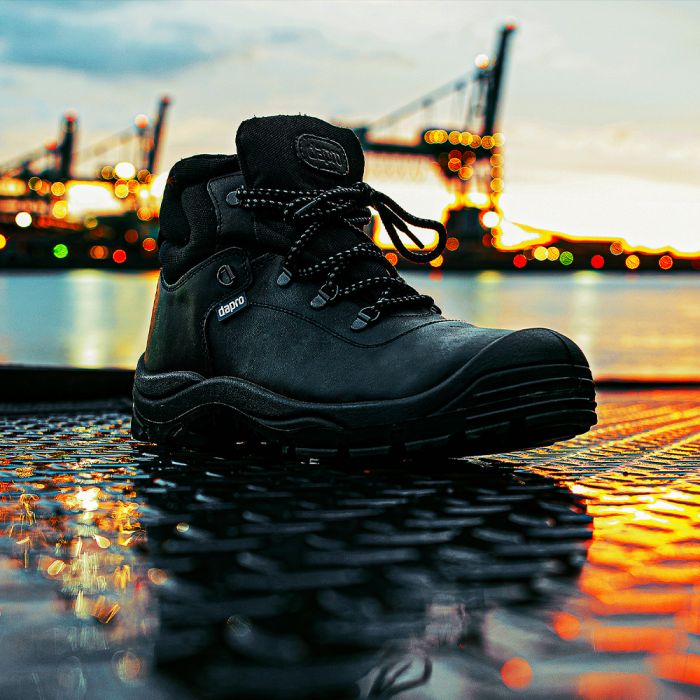Werken op zee , of het nu op olieplatforms, windmolenparken of zeeschepen is, vereist strikte naleving van veiligheidsnormen. De omgeving kan ruw en onvoorspelbaar zijn, waardoor persoonlijke beschermingsmiddelen (PBM) cruciaal zijn voor de veiligheid van werknemers. Gespecialiseerde veiligheidskleding, schoenen en uitrusting zijn ontworpen om werknemers te beschermen tegen gevaarlijke omstandigheden zoals extreme weersomstandigheden, zware machines en het risico om overboord te vallen.
Belangrijke veiligheidskleding voor offshore-werk
-
Vlamvertragende kleding (FRC)
Offshore-werknemers worden vaak blootgesteld aan ontvlambare stoffen. Vlamvertragende kleding biedt essentiële bescherming tegen brandgevaren. Deze kledingstukken zijn gemaakt van speciale stoffen en zijn ontworpen om ontsteking te weerstaan, zelfdovend te zijn en brandwonden te minimaliseren. FRC is verplicht in industrieën zoals olie en gas. -
Thermische en waterdichte kleding
Offshore werk houdt vaak blootstelling aan barre weersomstandigheden in, zoals koude temperaturen, harde wind en water. Werknemers dragen thermische kleding om zich te beschermen tegen koude stress en waterdichte buitenlagen om droog te blijven in natte omgevingen. Offshore windmolenparken en zeeschepen vereisen vaak volledige immersiepakken in geval van noodgevallen. -
Kleding met hoge zichtbaarheid
Kleding met hoge zichtbaarheid (hi-vis kleding) is essentieel om ervoor te zorgen dat werknemers goed zichtbaar zijn, vooral in gebieden met weinig licht of veel verkeer. Hi-vis veiligheidsvesten , jassen of overalls worden vaak gedragen om de zichtbaarheid te verbeteren en het risico op ongelukken met zwaar materieel of voertuigen te verminderen.
Veiligheidsschoenen voor offshore-werknemers
-
Stalen neus laarzen
Offshore-omgevingen omvatten zware machines en bewegende apparatuur, waardoor stalen neuslaarzen een noodzaak zijn. Deze veiligheidslaarzen met stalen neus beschermen de voeten tegen vallende voorwerpen en verpletterende verwondingen, en bieden zowel veiligheid als duurzaamheid. -
Slipvaste zolen
Offshore-oppervlakken kunnen glad zijn door olie, water of puin. Slipvaste zolen zijn cruciaal om vallen te voorkomen en ervoor te zorgen dat werknemers hun evenwicht behouden in gevaarlijke omstandigheden. -
Waterdichte en geïsoleerde laarzen
Werknemers in natte en koude omgevingen hebben waterdichte laarzen met isolatie nodig om hun voeten droog en warm te houden. Offshore windmolenparken, olieplatforms en zeeschepen vereisen vaak dit niveau van bescherming, vooral bij ruwe zee of stormachtig weer.
Kritieke PBM voor offshore veiligheid
-
Veiligheidshelmen
Offshore-werknemers lopen het risico op hoofdletsel door vallende voorwerpen of stoten in besloten ruimtes. Veiligheidshelmen zijn vereist in alle actieve gebieden om te beschermen tegen impacts, met kinbanden om ervoor te zorgen dat de helm stevig op zijn plaats blijft. -
Veiligheidsbrillen of gezichtsschermen
Oogbescherming is essentieel bij het werken met chemicaliën, puin of apparatuur die schadelijke deeltjes kunnen projecteren. Veiligheidsbrillen beschermen de ogen, terwijl gezichtsschermen extra bescherming bieden voor het hele gezicht bij het werken met materialen met een hoog risico. -
Gehoorbescherming
Offshore-faciliteiten kunnen extreem lawaaierig zijn, vooral rond zware machines en boorapparatuur. Oordopjes of oorkappen helpen de blootstelling aan hard geluid te verminderen, waardoor gehoorschade op den duur wordt voorkomen. -
Ademhalingsbescherming
Afhankelijk van de taak kunnen werknemers worden blootgesteld aan gevaarlijke dampen, gassen of stof. Respirators of maskers beschermen de longen tegen het inademen van schadelijke stoffen, waardoor de ademhalingsgezondheid van werknemers behouden blijft. -
Valbeveiliging
Werken op hoogte komt veel voor op offshore booreilanden en platforms. Valbeveiliging , zoals harnassen en lanyards, is essentieel om ernstig letsel te voorkomen. Werknemers worden vaak vastgemaakt aan veiligheidslijnen om het risico op vallen van verhoogde structuren te minimaliseren. -
Handschoenen
Handen worden vaak blootgesteld aan scherpe gereedschappen, chemicaliën en hete oppervlakken. Beschermende handschoenen — of ze nu chemisch bestendig, hittebestendig of snijbestendig zijn — zijn essentieel om verwondingen aan de handen te voorkomen.
Conclusie
Veiligheidskleding, schoenen en PBM zijn niet-onderhandelbare vereisten voor offshore werken. Van vlamvertragende kleding en stalen neuslaarzen tot helmen en harnassen, deze items zorgen ervoor dat werknemers beschermd blijven tegen de gevaarlijke omstandigheden die veel voorkomen in offshore-omgevingen. Door de juiste uitrusting te dragen, kunnen offshore-werknemers hun taken met vertrouwen uitvoeren en het risico op letsel of ongelukken aanzienlijk verminderen.



